Historically speaking, the classical guitar is a rather new instrument. The guitar has a rich family history. There are many early guitar cousins, so to speak, that preceded the six-stringed instrument we all know and love today. We’ll look at some of the most important cousins within the guitar’s family tree: the lute, the theorbo, the baroque guitar, and the vihuela. After a brief discussion of the history and description of each, we’ll talk about their tunings, scores associated with these instruments, and some of the best-known composers for each.
Early Guitar Cousins: Common Terminology
First, before we begin, let’s go over some common terminology for these early instruments that will come up again and again below:
- Courses: A pair of strings either in unison with one another or one octave apart; each course should be played simultaneously.
- Re-entrant tuning: Strings do not ascend in pitch from lowest to highest, but are re-ordered with some strings tuned an octave lower.
- Continuo: The bass part in an ensemble, or group of instruments, which met the need for a depth of sound with a rich bass line and harmony below other brighter, thinner sounding instruments.
- Campanella: A technique where fretted notes and open strings ring over one another to create a “bell”-like sound.
Early Guitar Cousins: The Lute
The lute’s history is tied up with the Mozarabic traditions in Spain. It dates at least as far back as the eighth century when the Moors conquered the Iberian peninsula. The term “lute” itself comes from an older Arabic instrument, the oud. The oud has a documented history going back even before the Persian Empire into Mesopotamia. The Arabic term for the lute is عود, which is often transliterated into English as oud, ʿud, or al-ʿūd. The lute we know today developed over the course of many hundreds of years and eventually became distinct from the oud around the thirteenth century.
From the Oud to the Lute
It was during the rise of the Renaissance, however, that the four-course instrument previously played with a plectrum became a six-course instrument plucked by the fingers of the right hand. While previously the oud and early lute were instruments for accompanying a vocalist, during the Renaissance the lute became a continuo instrument. For this reason, lutes during the Renaissance began adding more (and lower) courses of strings. Subsequently the necks of these instruments grew longer and longer to accommodate these lower strings.
Diversity of Lutes
During the Baroque period the lute in Germany had as many as 13 courses. This style of lute was common with the lute music of Sylvius Leopold Weiss. Also during this time, however, the lute once again became a popular instrument for vocal accompaniment. This was especially true in France with the court of Louis XIV. Putting all these pieces together we can see a great diversity in lutes and in music written for lutes. Lutes differed in France, Spain, Germany, and Italy. And music for the lute included continuo music, vocal music, and solo instrumental music written for these various lute instruments.
This diversity of instruments also meant that there was a diversity in tuning. The most popular tuning from the Renaissance was, from low to high: G, C, F, A, D. Guitarists today can approximate this tuning by tuning the third string down one half-step to F# and placing a capo on the third fret.
Lute Tablature
Not only is there diversity in the tuning of the instruments but there is also a great diversity among tablature, or notation systems for the lute. The most common forms are French, Spanish, and Italian.
French tablature
French tablature uses six lines on the staff, similar to modern guitar notation, but uses letters rather than numbers to denote open string and frets. The top line is the highest-sounding string, and the bottom line the lowest. In this system, “a” is the open string, “b” is the first fret, “c” the third, and so on. (This goes all the way up to the ninth fret, which is “k”—the letter “j” is not used in this system.) Above the top line different stems were used to denote various rhythms. And these rhythms differ from modern standard notation. Fingerings for the right hand appeared as dots above the numbers. Ornament symbols also appeared above the top line.
While only six lines are present on the staff, sometimes additional notes would be placed below the bottom line. These represent lower courses of open, unfretted strings called “diapasons.” A set of slashes indicates which string to play. For instance, the sixth string was “a,” the seventh string was “/a,” and the eighth string would be “//a,” and so on.
Italian Tablature
Italian tablature is closer to modern guitar tablature because it uses numbers rather than letters. However, unlike modern TAB, Italian tablature in most versions has the lowest sounding string on the top line, not the bottom. (Do keep in mind, that there were also “inverted” Italian tablatures, however.) Like French tablature, rhythmic stems (sometimes also with noteheads, but with the same rhythmic values) are present above the top line of the staff in Italian tablature.
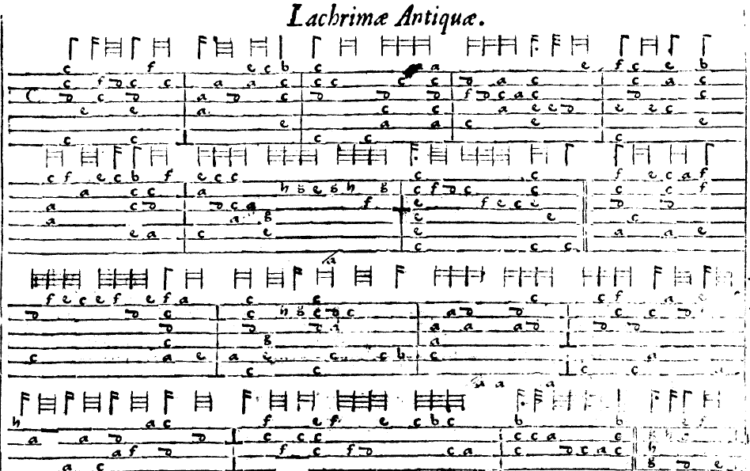
While there are too many composers to name because of this huge diversity, the name almost universally associated with the lute is John Dowland. Dowland wrote hundreds of compositions for the instrument and many of those have become classics on the classical guitar as well.
Early Guitar Cousins: The Theorbo
The theorbo is itself an early cousin of the lute but has a much longer neck to accommodate its several low bass strings (called “diapasons”). The instrument originally came from Italy and most of its best music is either from Italy or France. Theorbos typically had either 15 or 14 courses of strings. Like the lute, the theorbo was a continuo instrument through much of its life, accompanying other instruments in ensemble. It was, however, also an instrument for accompanying the voice.
Re-entrant tuning
The tuning of the instrument differed from place to place, but a common feature of the theorbo that set it apart from some other instruments is that it uses a re-entrant tuning. This allows the theorbo to have a great versatility and makes it an ideal instrument for “campanella” fingerings.
Theorbo Tablature
Theorbo tablature is essentially the same as lute tablature, but uses diapasons much more frequently.
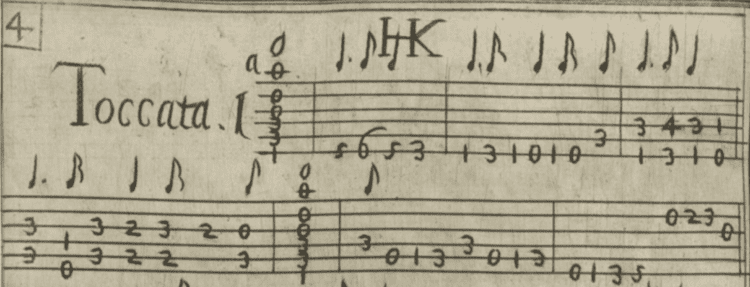
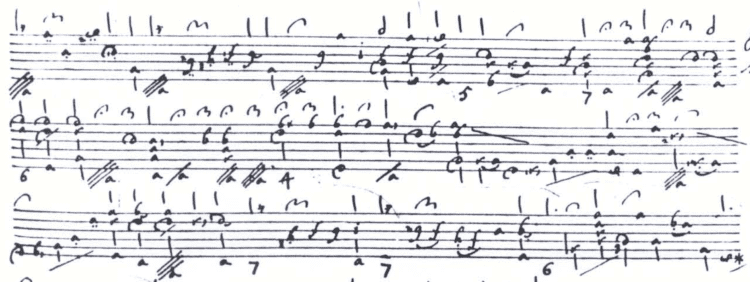
The best known composer for the theorbo was Giovanni Girolamo Kapsberger.
Early Guitar Cousins: The Vihuela
The vihuela (or vihuela da mano) is a Spanish instrument and uses the same basic tuning as the Elizabethan lute, though it is much smaller. The vihuela was an instrument of the aristocracy during the Spanish Renaissance. For this reason, music for the vihuela was polyphonic and often highly contrapuntal, reflecting popular compositional styles in the Spanish court.
The vihuela’s tuning is, once again: G, C, F, A, D (like the Renaissance lute).
Vihuela Tablature
Vihuela tablature is very close to modern guitar tablature. In fact, by tuning the third string to F# a modern guitarists can read vihuela tablature just like guitar TAB.
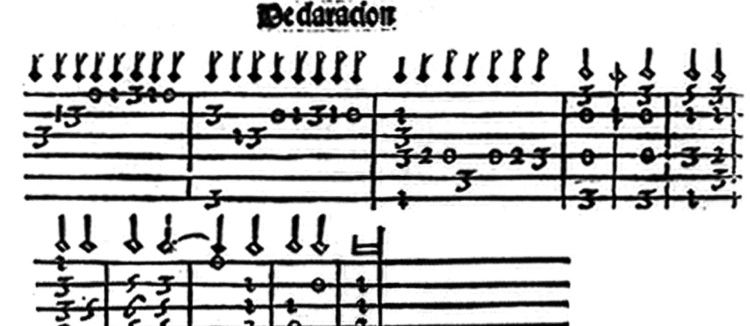
There are, again, many great composers for the vihuela. The largest collection of pieces written for the instrument comes from Miguel Fuenllana in 1554. However, the most popular vihuela composer is Luys Milan, whose El Maestro was written in 1536 and is the earliest known source of music for the instrument.
Early Guitar Cousins: The Baroque Guitar
Like the theorbo, the Spanish baroque guitar used a re-entrant tuning. It was a very different instrument, however. Much smaller than both the theorbo and the lute, the baroque guitar was often found in the home because of its size and its affinity with folk music. Possessing only five courses, the baroque guitar incorporated many new techniques, including strumming, which made it an excellent instrument for accompaniment. In addition, like on the theorbo, the re-entrant tuning allows for wonderful campanella textures that enable speed and grace. These techniques made the baroque guitar a perfectly suitable instrument for folk music.
Baroque Guitar Tablature
Music for baroque guitar in Italy and Spain used Italian tablature on a five-line staff (to indicate the five courses). Thus, the lowest-sounding string is on the top of the staff. Unlike lute tablature, dots next to notes in Spanish tablature indicate left-hand fingerings. Rhythmic stems (or noteheads and stems) above the top line function in the same way as in all other systems.
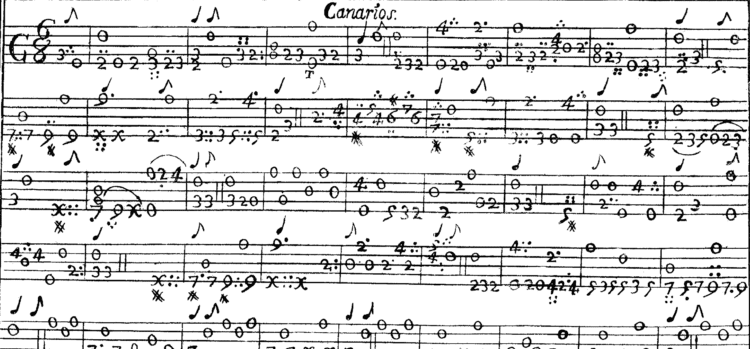
Some well-known composers for the baroque guitar include Robert de Visée in France and Santiago de Murcia in Spain. However, perhaps the most popular baroque guitar composer is Gaspar Sanz, whose Instrucción de música sobre la guitarra española (1674) is the earliest method written for the guitar.
***
This is only an overview of a handful of the guitar’s early cousins—there are many other members to the guitar’s family tree! We hope this has been helpful. We’ve produced a quick-start guide you can download below that includes a handy rundown of the differences between each of these early instruments.

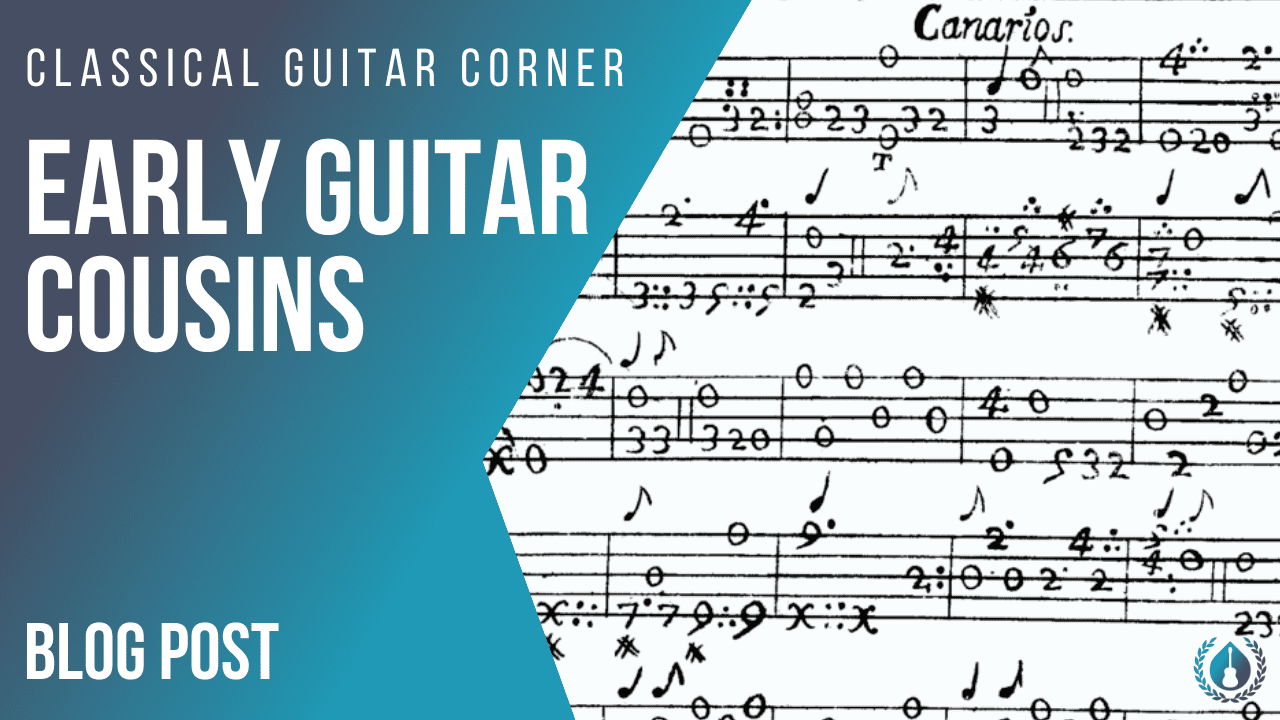
Well done, this article captures key elements of the guitar’s family of instruments. Reading French tablature and other forms of notation offers expanded insight for guitarists:)
Thanks, Drew! Being able to translate tablature to our instrument is so beneficial and opens up a world of early music!
Peace,
Dave B (CGC team)
Thank you for this, very interesting and useful. I love Renaissance and baroque music opening a world on its own
Very interesting background info (& examples). Thanks for the extensive research.
Thanks for the nice comment, Roy! We hope the post was useful for you.
Peace,
Dave B (CGC team)